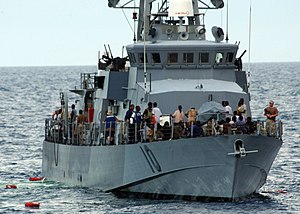USS Firebolt
 The USS Firebolt, laden with 89 survivors rescued from the Gulf of Aden after their small vessel capsized 29 April 2005.
| |
| History | |
|---|---|
| Name | USS Firebolt |
| Operator | |
| Ordered | 19 July 1991 |
| Builder | Bollinger Shipyards |
| Laid down | 17 September 1993 |
| Launched | 10 June 1994 |
| Commissioned | 10 June 1995 |
| Homeport | Naval Amphibious Base Little Creek |
| Status | In active service, as of 2015 |
| Badge |  |
| General characteristics | |
| Class and type | Cyclone-class patrol ship |
| Displacement | 331 long tons (336 t) |
| Length | 174 ft (53 m) |
| Beam | 25 ft (7.6 m) |
| Draft | 7 ft 6 in (2.3 m) |
| Propulsion |
|
| Speed | 35 kn (40 mph; 65 km/h) |
| Complement |
|
| Armament |
|
USS Firebolt (PC-10) is the 10th member of the Cyclone-class of coastal patrol boats. She is a 174 ft (53 m) vessel with a crew of approximately 30 sailors, normally homeported at Naval Amphibious Base Little Creek, Norfolk, Virginia. Her armament includes two Mk38 chain guns, two Mk19 automatic grenade launchers, and two .50 in (12.7 mm) machine guns, as well as six Stinger missiles.[3] She was laid down by Bollinger Shipyards on 17 September 1993, launched on 10 June 1994, and commissioned into the Navy on 10 June 1995.[2]
Persian Gulf service
In February 2003, Firebolt deployed to Bahrain to operate in the Persian Gulf in support of Operation Enduring Freedom and Operation Iraqi Freedom. While there, she rotated crews so that she could remain on station without returning home for leave. In February 2004, Firebolt collided with a navigational buoy off the coast of Iraq. The subsequent inquiry board into the incident led to the removal of Lieutenant Commander Michael T. Sullivan from command.[4]
On 24 April 2004, Firebolt's rigid-hulled inflatable boat attempted a boarding operation on a dhow that was approaching the Khawr Al Amaya Oil Terminal in Iraq. As the boarding team of seven pulled alongside, the dhow exploded in an apparent suicide bombing. Two sailors—Petty Officer First Class Michael J. Pernaselli, 27, and Petty Officer Second Class Christopher E. Watts, 28, and one Coast Guardsman, Petty Officer Third Class Nathan Bruckenthal, 24—[5] were killed when the explosion flipped the boat over, dumping her crew into the water. Bruckenthal, a member of the embarked Law Enforcement Detachment, was the first Coast Guardsman to die in action since the Vietnam War. The survivors were picked up by an S-70B-2 Seahawk helicopter from the Australian frigate HMAS Stuart.[6]
Photos
-
USS Firebolt at Yorktown Naval Weapons Station
References
- ^ a b "USS FIREBOLT". Naval Vessel Register. NAVSEA Shipbuilding Support Office. Retrieved 31 January 2007.
- ^ Geibel, Adam (22 October 2003). "Cyclones, Firebolt and the Persian Gulf Pirates". Dirty Little Secrets. StrategyWorld.com. Retrieved 23 September 2006.
- ^ U.S. 5th Fleet Public Affairs (1 April 2004). "Firebolt's Commanding Officer Relieved". Navy NewsStand. Naval Media Center. Retrieved 22 September 2006.
{{cite web}}: CS1 maint: numeric names: authors list (link) - ^ Capelotti, Peter (25 April 2003). "DC3 Nathan Bruckenthal's Oral History". U.S. Coast Guard Historian's Office. Retrieved 23 September 2006.
- ^ Helmer, Kendra (27 April 2004). "Suicide bombing attack claims first Coast Guardsman since Vietnam War". Stars and Stripes. Retrieved 26 August 2010.
External links
 This article includes information collected from the Naval Vessel Register, which, as a U.S. government publication, is in the public domain. The entry can be found here.
This article includes information collected from the Naval Vessel Register, which, as a U.S. government publication, is in the public domain. The entry can be found here.

